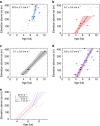Mid-Holocene pulse of thinning in the Weddell Sea sector of the West Antarctic ice sheet
- PMID: 27545202
- PMCID: PMC4996935
- DOI: 10.1038/ncomms12511
Mid-Holocene pulse of thinning in the Weddell Sea sector of the West Antarctic ice sheet
Abstract
Establishing the trajectory of thinning of the West Antarctic ice sheet (WAIS) since the last glacial maximum (LGM) is important for addressing questions concerning ice sheet (in)stability and changes in global sea level. Here we present detailed geomorphological and cosmogenic nuclide data from the southern Ellsworth Mountains in the heart of the Weddell Sea embayment that suggest the ice sheet, nourished by increased snowfall until the early Holocene, was close to its LGM thickness at 10 ka. A pulse of rapid thinning caused the ice elevation to fall ∼400 m to the present level at 6.5-3.5 ka, and could have contributed 1.4-2 m to global sea-level rise. These results imply that the Weddell Sea sector of the WAIS contributed little to late-glacial pulses in sea-level rise but was involved in mid-Holocene rises. The stepped decline is argued to reflect marine downdraw triggered by grounding line retreat into Hercules Inlet.
Figures





References
-
- Golledge N. R. et al. Glaciology and geological signature of the Last Glacial Maximum Antarctic ice sheet. Quat. Sci. Rev. 78, 225–247 (2013).
-
- Stone J. O. et al. Holocene deglaciation of Marie Byrd Land, West Antarctica. Science 299, 99–102 (2003). - PubMed
-
- Whitehouse P. L., Bentley M. J. & Le Brocq A. M. A deglacial model for Antarctica: geological constraints and glaciological modelling as a basis for a new model of Antarctic glacial isostatic adjustment. Quat. Sci. Rev. 32, 1–24 (2012).
-
- Weber M. E. et al. Millennial-scale variability in Antarctic ice-sheet discharge during the last deglaciation. Nature 510, 134–138 (2014). - PubMed
-
- Bentley M. J. et al. A community-based geological reconstruction of Antarctic Ice Sheet deglaciation since the Last Glacial Maximum. Quat. Sci. Rev. 100, 1–9 (2014).
Publication types
LinkOut - more resources
Full Text Sources
Other Literature Sources

